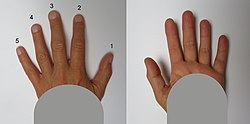| Finger | |
|---|---|
 The fingers of a left hand seen from both sides | |
| Details | |
| Identifiers | |
| Latin | digiti manus |
| MeSH | D005385 |
| TA98 | A01.1.00.030 |
| TA2 | 150 |
| FMA | 9666 |
| Anatomical terminology | |
A finger is a prominent digit on the forelimbs of most tetrapod vertebrate animals, especially those with prehensile extremities (i.e. hands) such as humans and other primates. Most tetrapods have five digits (pentadactyly),[1][2] and short digits (i.e. significantly shorter than the metacarpal/metatarsals) are typically referred to as toes, while those that are notably elongated are called fingers. In humans, the fingers are flexibly articulated and opposable, serving as an important organ of tactile sensation and fine movements, which are crucial to the dexterity of the hands and the ability to grasp and manipulate objects.